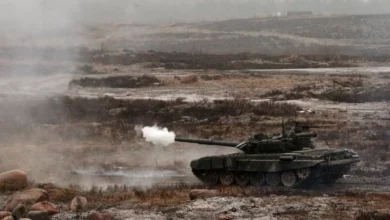Akhmim village, Sohag– Two women, clad in black, and a young girl are kneeling over a pile of burning paper at the entrance of Akhmim village’s sole, seven-century-old cemetery. They are partaking in what appears to be a death ritual, blowing wisps of smoke with pieces of cardboard papers, and speaking in hushed, hurried tones.
“My husband is buried here,” says the younger of the two women before they scurry off into the narrow alley that leads to his grave.
But not for long. At the end of April, Sohag’s governor announced that as of 1 May, the 150,000 residents of Akhmim would be banned from burying their dead in their traditional cemetary, which Egypt’s Supreme Council of Antiquites (SCA) recently designated as an archeological site.
On 27 April over 10,000 Akhmim villagers expressed their anger by rioting in front of Sohag’s local council, pelting the building with stones and burning tires. Thirty were arrested, but the governor’s verdict remained unchanged.
Since the cemetary was closed to the public, more than 50 bodies have been buried in a new cemetery on the outskirts of the village–a 77 feddan, LE80 million project funded equally by the SCA and the governorate. Bodies from the old cemetery, numbering in the thousands, will gradually be moved by their families after the Ministry of Health and Al-Azhar complete reports evaluating health and religious concerns. It will take months before the transfer process is approved.
It seems as though tensions over the decision are still running high. Police vigilintly followed as Al-Masry Al-Youm toured the village, making it difficult to interact with locals. The fidgety group of police officers politely, but insistently escorted Al-Masry Al-Youm out of the village, suggesting a nearby Sohag hotel as the appropriate location for further interviews.
But the local SCA officials insist that they have made progress easing the minds of the villagers.
“It is certainly a sensitive issue–every one cares about their deceased loved ones,” said Zein el-Abedeen Zaki, SCA General Director of Sohag. “But the people are now convinced.”
According to Zaki, the governor has expended much effort to properly organize the logistics for the funerals of the recently deceased, providing cars to carry corpses and sending buses to take family members to funerals. This will remain the case for all future burials in the new cemetery, he said.
Zaki attributed last month’s riots to politics, saying that people were expressing frustration over the upcoming Shura Council elections.
“There were mostly young people there,” he said. “The older, wiser people in the town are okay with things now.”
Zaki also mentioned that the proximity of the cemetery to people’s homes was a health hazard. The residents of Akhmim are indeed close to their dead–literally–with only a few feet dividing the cemetery walls from homes and shops.
SCA General Director of Akhmim Gamal Abdel Nasser, a native of the village, supported his colleague’s claims.
“People have accepted and have a desire to use the new cemetery,” Abdel Nasser said. “The old cemetery is not benefiting the city.”
Akhmim has long been an important archeological hub. In 1981, a colossal statue of Ramses II and his daughter Meritamen were discovered among the remains of a Greco-Roman temple. Ten years later, just 50 meters from where Meritamen was discovered, excavators unearthed the lower half of another massaive statue of Ramses II. The extensive cemeteries of ancient Akhmim are yet to be fully explored, but they may sit on top of the temple.
“We don’t know where the temple begins, and where it ends,” explained Zaki. “We believe that we may find more massive statues buried beneath the ground,” he said, adding that nomadic Arabs from the fifth and sixth centuries documented their own findings.
Such discoveries, supporters of the cemetary ban say, will lead to a significant boost in tourism for Akhmim, which currently sees only sporadic visits from foreigners passing through on their way from Luxor. The construction of Sohag’s new airport, as well as a museum of antiquities, parallel efforts to increase visits to Sohag.
Meanwhile, the people of Akhmim will gradually begin to do their own unearthing. While a surge in tourism to the area remains uncertain, evacuating the cemetary is guaranteed to be a painful process.




